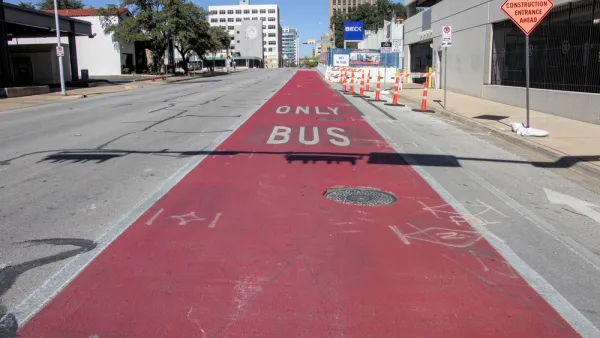A once sprawling and singularly ambitious capital investment plan for the Capital Metro system will soon be reduced in size and scope. The episode is more evidence of an emerging era of transit planning austerity.

Project Connect, the Austin region’s far-reaching and sweeping transit investment plan was made possible when voters approved a new 8.75-cent property tax in 2020. Since then, however, Capital Metro’s planning partners have struggled to begin projects, a trend that culminated with an announcement in 2022 that a reduction from the original vision set forth by the plan was necessary.
On the cusp of a community engagement process to consider revisions to the plan, an article published by TransitCenter considers the lessons from Project Connect as transit agencies around the country—most notably in Atlanta and New York City—reduce their planning ambitions amid labor shortages, increasing construction costs, inflation, and stagnant ridership.
The sources quoted in the article discuss the lessons learned so far, about the importance of governance and the challenges presented by unforeseen engineering and political obstacles.
Overall, the message from local advocates is optimistic. Project Connect is still viable, it just has a few hurdles still to overcome.
FULL STORY: Austin’s First Attempt at a Big, Urban Transit System Has More Obstacles to Overcome

National Parks Layoffs Will Cause Communities to Lose Billions
Thousands of essential park workers were laid off this week, just before the busy spring break season.

Retro-silient?: America’s First “Eco-burb,” The Woodlands Turns 50
A master-planned community north of Houston offers lessons on green infrastructure and resilient design, but falls short of its founder’s lofty affordability and walkability goals.

Delivering for America Plan Will Downgrade Mail Service in at Least 49.5 Percent of Zip Codes
Republican and Democrat lawmakers criticize the plan for its disproportionate negative impact on rural communities.

Test News Post 1
This is a summary

Test News Headline 46
Test for the image on the front page.

Balancing Bombs and Butterflies: How the National Guard Protects a Rare Species
The National Guard at Fort Indiantown Gap uses GIS technology and land management strategies to balance military training with conservation efforts, ensuring the survival of the rare eastern regal fritillary butterfly.
Urban Design for Planners 1: Software Tools
This six-course series explores essential urban design concepts using open source software and equips planners with the tools they need to participate fully in the urban design process.
Planning for Universal Design
Learn the tools for implementing Universal Design in planning regulations.
EMC Planning Group, Inc.
Planetizen
Planetizen
Mpact (formerly Rail~Volution)
Great Falls Development Authority, Inc.
HUDs Office of Policy Development and Research
NYU Wagner Graduate School of Public Service




























